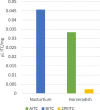Antimicrobial effects of mustard oil-containing plants against oral pathogens: an in vitro study
- PMID: 32448381
- PMCID: PMC7247255
- DOI: 10.1186/s12906-020-02953-0
Antimicrobial effects of mustard oil-containing plants against oral pathogens: an in vitro study
Abstract
Background: The present study examines the antimicrobial activity of nasturtium herb (Tropaeoli maji herba) and horseradish root (Armoraciae rusticanae radix) against clinically important oral bacterial pathogens involved in periodontitis, gingivitis, pulpitis, implantitis and other infectious diseases.
Methods: A total of 15 oral pathogens, including members of the genera Campylobacter, Fusobacterium, Prevotella, Parvimonas, Porphyromonas, Tanerella, Veillonella, and HACEK organisms, were exposed to [1] a combination of herbal nasturtium and horseradish using a standardized gas test and [2] a mixture of synthetic Isothiocyantes (ITCs) using an agardilution test. Headspace gas chromatography mass spectrometry was employed to quantify the amount of allyl-, benzyl-, and 2- phenyl- ethyl-ITC.
Results: With exception of Veillonella parvula, all tested species were highly susceptible to herbal nasturtium and horseradish in the gas test with minimal inhibitory concentrations (MICs) between 50/20 mg and 200/80 mg and to synthetic ITCs in the agardilution with MICs between 0.0025 and 0.08 mg ITC/mL, respectively. Minimal bactericidal concentrations extended from 0.005 mg ITC/mL to 0.34 mg ITC/mL.
Conclusions: ITCs may be considered an interesting alternative to antibiotics for prevention and treatment of oropharyngeal infections, periodontitis and related diseases. Furthermore, the suitability of ITCs for endocarditis prophylaxis in dental procedures might be worth further investigation.
Keywords: Endocarditis prophylaxis; Horseradish; Isothiocyanates; Mustard oils; Nasturtium; Periodontitis.
Conflict of interest statement
The authors declare that they have no competing interests.
Figures



References
-
- Renwick MJ, Simpkin V, Mossialos E. European Observatory Health Policy Series. Targeting innovation in antibiotic drug discovery and development: The need for a One Health - One Europe - One World Framework. Copenhagen (Denmark): European Observatory on Health Systems and Policies World Health Organization 2016; 2016. - PubMed
MeSH terms
Substances
Grants and funding
LinkOut - more resources
Full Text Sources
Medical

